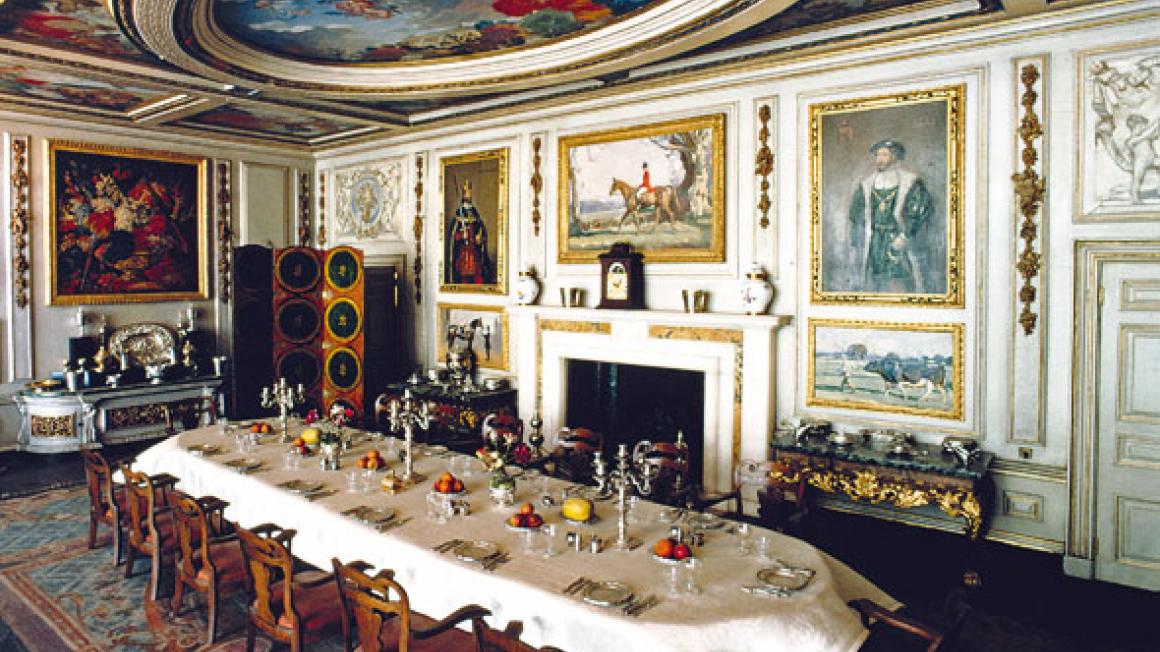MINIATURE MARVELS
At just over 5ft tall, Queen Mary’s doll’s house is a remarkable tribute to the craftsmanship of miniatures. Now on permanent display at Windsor Castle, it boasts working plumbing and electrics alongside specially chosen, nip-sized bottles of wine in the cellar. Even through the keyhole, close-up photographs fail to reveal its tiny stature. In short, it is a miniature marvel.
 1 A marquetry cabinet 2 A 5p coin shows the scale of the models 3 and 4 Exterior and interior of Crosthwaite Cottage (c.1750), Devon
1 A marquetry cabinet 2 A 5p coin shows the scale of the models 3 and 4 Exterior and interior of Crosthwaite Cottage (c.1750), DevonDolls’ houses have been the object of dreams and aspiration for centuries. You might live in a small cottage in Surrey but that doesn’t mean that you don’t fancy becoming Lady of a Queen Anne mansion occasionally.
And then there is the added benefit of being able to completely control the environment. With most adult collectors’ models made to a scale of 1:12 (children’s versions are 1:18), the chances of the cleaning getting too much are remote and with a miniscule dinner set, it would seem churlish not to do the washing-up.
 5 A Regency town house with Georgian footman and gentleman caller 6 A Kensington Regency town house
5 A Regency town house with Georgian footman and gentleman caller 6 A Kensington Regency town houseThe first recorded doll’s house was made for the duke of Bavaria in 1557-8, as a perfect copy of his official residence. Once they became a royal pastime, the upper classes of Europe commissioned their own versions, often as a way of showing off the owners’ wealth and of explaining to their marriageable daughters the concept of house management. It wasn’t unusual for the dolls’ houses to have staff quarters, coaches and liveried footmen.
From the end of the 17th century the passion for all things miniature grew, with collectors particularly keen on tiny replicas in silver, porcelain or glass. While the Dutch displayed their collections in cabinets, the English increasingly had small houses, ‘baby houses’ as they were called.
 7 Tiny books 8 A miniature contemporary home 9 Even tiny artwork was painted 10 A miniature handheld Aga
7 Tiny books 8 A miniature contemporary home 9 Even tiny artwork was painted 10 A miniature handheld AgaThese days, collectors tend to steer away from installing tiny occupants, preferring instead to keep the place to themselves, although many cannot resist pets. And why not? A thumbnail-sized kitten has an Ahh factor that would melt any cynic’s heart.
The craftsmanship and attention to detail in making a mini Aga or a perfectly turned wing-back chair is truly remarkable and in some cases the work involved would be greater than producing the full-size version. In fact, a true test of their skill is when you see a photograph of the piece and you can’t tell the difference between the miniature and the real thing. Or can you?
 11 An ornate mantle clock 12 Minute meals – a handcrafted casserole with vegetables, a chopping board and knife 13 An opulent Louis XIV-style room with gilt detail 14 A Louis XV-style gilt carver chair
11 An ornate mantle clock 12 Minute meals – a handcrafted casserole with vegetables, a chopping board and knife 13 An opulent Louis XIV-style room with gilt detail 14 A Louis XV-style gilt carver chairMINIATURE TREATS FOR YOUR DIARY
Miniatura International Dolls’ House Show, established in 1983, the show is held twice a year at the Birmingham NEC. Thousands of miniaturists marvel at handcrafted, perfectly scaled, museum-quality models. The next show is on 29 and 30 March.
0121-767 4100, www.miniatura.co.uk
For collectors and enthusiasts, the Kensington Dollshouse Festival, running from 17 and 18 May, is another unmissable event. Established in 1985, it will be attended by over 170 of the top makers from around the world.
020-7812 9892, www.dollshousefestival.com
Wendy’s World Fairs runs popular shows around the country throughout the year for enthusiasts and traders.
01895-834348, www.wendysworldfairs.co.uk


